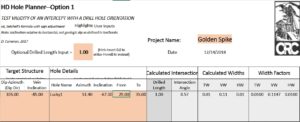For those vein miners who might read this, let’s discuss a bit about drilling angles. If any of us are asked if we want to drill across structure or down structure, most of us will always choose the former. For those who wouldn’t, please take this opportunity to find another website. Unfortunately, I think many holes are unwittingly drilled too close to paralleling a vein or a bed for a number of reasons: 1)Pressure for results; 2) Lack of platforms; 3)Secondary target; and 4)Poor, or no planning.
Not so long ago I encountered one case of great left-lateral leaps in illogic where a drilling program was undertaken to test very narrow veins at very low angles, but great attention was paid to oriented core measurements. Fellow geologists, I’m sorry but I’m just going to lay down a figure—If your intercept angle with the target is determined to be 300 or less, throw it out of the resource estimate. I know this isn’t Russia, where standards are set and you have to follow them like the rules of the road, but enough of this 43-101 vagueness! You can’t know whether you are grazing the structure or crossing it if your holes are bouncing along a contact. The true width factor at a 300 angle is 0.5. We certainly also should plan our intercepts to be significantly better than 300 because we must expect undulating or complex contacts in the general case. The implications are significant for grade and tonnage estimation. I have kept to this rule in drilling and resource estimation. It is common sense and it doesn’t need to be left to the judgment of the QP.
Therefore, how do we plan our drill holes, especially those drilled as oblique fans? Some software like Micromine will straightforwardly calculate true width from the intersection of a planned or actual drill hole and an interpreted shape or plane, from which you can derive the intersection angle from the arcsin of the ratio of true width to “drilled” width. Or you can make yourself a spreadsheet template with the necessary formulas, supplying the orientation of the drilled plane and the trajectory of the drill hole as inputs. Something like the Handy Dandy Hole Planner!
Try out HD Hole Planner by contacting me for a password that will allow you to download one of two options. The first, Option 1, tests a proposed drill hole orientation and interval with a given plane, returning width factors and intercept lengths. Option 2 allows analysis of the feasibility of a given platform for testing a specific target, returning hole orientation and depth to target required plus an optional tail, the intercept angle and width factors. Type your password in below:
Option 1  Option 2
Option 2

6 Downloads
Option 2 12 Downloads
Type or paste your inputs in the unprotected salmon-colored cells. If you just want the width factors, leave the optional drill length input as 1.00, otherwise, replace it with a different intercept length or 0.0 to use drill hole ‘from’ and ‘to’ for calculation of true (and horizontal, vertical) widths plus the factors. The sheets look like this:
Option 1:
 Option 2
Option 2

